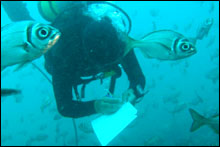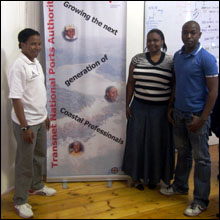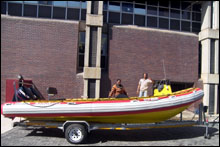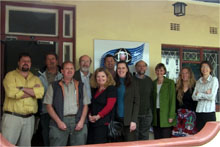SAEON Elwandle Node wraps up 2007
By Dr Angus Paterson, Node Manager
2007 is almost over, which concludes the Elwandle Node’s first year of operation.
The Node has grown considerably this year and is now fully staffed and equipped. In terms of 2007 highlights, the following activities and milestones stand out:
Staffing
Staffing in the current climate of a skills shortage in SA is challenging for any institution, but the Node has managed to secure a dynamic, representative and young staff complement who are all keen to see SAEON go from strength to strength.
In terms of in-house staff, post-docs and interns the node now numbers seventeen:
- Dr Angus Paterson – Manager
- Dr Kim Bernard – Data Scientist
- Dr Albrecht Gotz – Post-doc and leader of the Marine Protected Areas programme
- Dr Nikki James – Post-doc and leader of the applied monitoring programme
- Mr Sean Bailey – Senior technician and head of the SDU (Scientific Diving Unit)
- Mr Dumile Tshingana – Outreach and education officer
- Ms Tanith Grant – Part-time data clerk
- Mr Luckay Vumazonke – PhD intern
- Mr Anthony Bernard – PhD intern
- Mr Sean Deysel – PhD intern
- Mr Ntuthuku Masikane – MSc TNPA1 intern
- Mr Luzuko Dali – MSc TNPA intern
- Ms Mandisa Rubuxa – MSc TNPA intern
- Ms Bronwyn Palmer – MSc intern
- Mr Colley Mpako – Murray & Roberts intern
- Mr Lulama Poni – Murray & Roberts intern
- Mr Lungisile Koliti – Murray & Roberts intern
In addition, the Node has a number of students who are based at other institutions but are working in conjunction with SAEON:
- Mr Russel Chalmers – PhD candidate (RU2)
- Ms Angela Mead – PhD candidate (UCT3)
All in all, the Node is lucky to have recruited such a fine group of young researchers and students and much is expected of them over the next few years.
Collaboration
SAEON is a network organisation and as such must foster links between research institutions to undertake collaborative long-term research.
The Elwandle Node has made significant strides in forging these links and is collaborating on a range of different projects with various agencies:
- DWAF4 – Knysna freshwater reserve studies
- C.A.P.E5 – Estuaries programme
- Rhodes University – Near-shore and estuarine monitoring and research
- NMMU6 & SAIAB7 – Estuary climate change studies
- TNPA8 – National Ports Monitoring exercise
- SAIAB – Marine protected area monitoring
- UCT – 70 years of change in South African Rocky Intertidal Region
- RU/UDW9 – Drivers of coastal land-use change
- MCM10 – Marine protected area monitoring
- EFA11 and SANParks12 – Marine protected area establishment and monitoring
In addition, there are a number of other initiatives which are currently being developed or proposals which have been submitted to a range of agencies. These include:
- WWF13 - Marine monitoring of the Table Mountain Marine Park
- MCM/MLRF14 - East Coast upwelling and climate change
- ACCESS15 - Operational oceanography in conjunction with the SAEON Egagasini Node for marine-offshore systems
- ACEP16 - Linking inshore and offshore processes along the East Coast of South Africa
- OTN17 - Setting up an ocean telemetry tracking system in Algoa Bay
|
Data
In order for future generations to understand global change, the archiving of long-term data sets is a key focus area of SAEON. In 2007, SAEON finalised its data policy which allows for full ownership rights of scientists, but also ensures that others know of the data sets available and allows long-term archiving.
Two initial projects are in the process of being launched:
- The establishment of a national estuarine database
- Digitising all the Southern Oceans Research Groups (RU) long-term data in conjunction with the SAEON offshore node
Dr Kim Bernard, the node’s data scientist, and Ms Tanith Grant are leading this process and Phase 1 will hopefully be completed by the end of 2008.
Capacity building and outreach
With the arrival of Dumile Tshingana to head up the outreach component of the Node, a further core thrust of SAEON is taking shape.
In the few months that he has been with SAEON he has travelled extensively and networked widely. Dumile will be launching the Node’s pilot coastal schoolyard LTER18 programme in Kenton-on-Sea and Port Alfred in 2008. The schoolyard programme will complement the outreach activities undertaken by SAIAB, who currently houses Dumile and with whom he works very closely.
In terms of outreach the Node has had two major success stories with externally funded projects:
Transnet National Ports Authority – Building the next generation of coastal professionals programme. This programme has involved the TNPA investing heavily in three previously disadvantaged students to allow them to undertake their MSc degrees. Their continued input into SAEON is greatly appreciated.
Murray & Roberts Steel Para-taxonomy Programme. At the 2006 US LTER All Scientist Meeting in Colorado, the take home message was that if you wish to do good LTER you had best have good quality control and continuity in the staff that sort and identify your biological samples.
The challenge facing the Node was - how do you train students knowing that they will leave, and still retain sufficient continuity in sample analysis? This challenge is even more difficult in the South African research environment, as we have never encouraged or recognised the need for high quality technical support.
The answer is simple - train your own technicians. From this need the Node secured funding from Murray & Roberts Steel to train three disadvantaged disabled individuals. The programme has been an overwhelming success and the services of these men are not only required internally, but we have contracted their skills to two other researchers at Rhodes University as well.
|
Equipment
The National Research Foundation (NRF) and Department of Science and Technology (DST) look to SAEON to not only foster LTER, but also make wise use of research resources.
As discussed in previous issues of the SAEON e-News, the Node will initially be concentrating on the warm temperate coastal bio-region with Algoa Bay as the core site.
After some initial discussion with the researchers in the region, one of the major limiting factors for near-shore work was the lack of a suitable boat. A number of the institutions in the region (RU, SAIAB, NMMU and BayWorld) have tried to maintain a suitable near-shore boat, but due to research cycles and costs this has proved to be difficult.
The Node has now purchased an 8-metre semi-rigid with two 115 hp outboards and all the required high-tech instrumentation. This boat, which will be housed at NMMU, will be available to all researchers who wish to register a project with SAEON.
This is a big leap in institutional equipment lending so watch future articles to see how it is going. The Node is certainly hoping to disprove a number of scientists who have indicated that sharing never works, but as Barney the purple dinosaur says, “Sharing is Caring”!
At present researchers from all the major institutions are interested in utilising the boat.
|
Liaison Committee
As a network organization, the Node relies on collective wisdom and in this case it is provided by the Node’s liaison committee.
The initial committee is made up of senior coastal researchers and managers and includes the following non-SAEON individuals:
- Dr Alan Whitfield – SAIAB
- Professor Tris Wooldridge – NMMU
- Professor William Froneman – RU and SANCOR Chair
- Dr Ané Oosthuizen – SANParks
- Ms Judy Mann-Lang – Seaworld
- Professor Janine Adams – NMMU
- Ms Susan Taljaard – CSIR
- Dr Andrew Cockcroft – MCM
The Node Liaison Committee had its inaugural meeting in October 2007 and this meeting’s outcomes will culminate in the production of the Node’s five-year science and management plan. The input provided by these individuals is greatly appreciated.
|
Expansion into the Western Cape
One of the more exciting recent developments has been the Node’s expansion into the Western Cape.
For logistical and budgetary reasons the Node was initially going to concentrate on warm temperate regions of SA, with future phases moving into the cool temperate and sub-tropical coastal regions.
However, discussions between the Saldanha Water Quality Forum Trust and SAEON have resulted in SAEON playing a role in the Western Cape well ahead of schedule. The Trust is a non-governmental trust of the major industries in the area who wish to ensure the long-term health of the system.
SAEON will be playing a science advisory role to the Trust and will be archiving all the long-term environmental data that the Trust collects through its various service providers. The Node is looking to play a major facilitation role in the Saldanha and Langebaan region, an area of significant biodiversity as well as national economic significance.
Way forward
Whereas the Node’s inception year has been very productive, it has mostly been orientated around getting things started.
2008 will involve the following key activities:
- Finalising the science plan
- A national tour to key facilities
- Submission of a number of larger collaborative programme proposals to the NRF
- Hopefully, the initiation of a number of programmes that are “on the boil” with agencies such as OTN, ACEP and the MLRF.
Wrap up
An end-of-year update would not be complete without a number of acknowledgements from the Node and its staff.
While many people have made the Node’s first year a success, the following individuals must be singled out:
Our bosses – To Johan Pauw and Paul Skelton, thanks for all the support and the latitude for us to get on with it.
Administrative support – To Wendy Sweetman and Linda Coetzee, and their respective teams at SAIAB, thanks for your tireless input and most of all, your patience.
Donors – To Leticia Greyling at Transnet National Ports Authority and Catharine Payze at Murray & Roberts Steel, thanks for believing that SAEON can play a positive role in outreach and capacity building.
Related article: 2007 – Looking back on moving forward
[1] Transnet National Ports Authority
[2] Rhodes University
[3] University of Cape Town
[4] Department of Water Affairs and Forestry
[5] Cape Action Plan for the Environment
[6] Nelson Mandela Metropole University
[7] South African Institute of Aquatic Biodiversity
[8] Transnet National Ports Authority
[9] University of Durban Westville
[10] Marine & Coastal Management
[11] EnviroFish Africa
[12] South African National Parks
[13] World Wide Fund for Nature
[14] Marine Living Resources Fund
[15] African Centre for Climate and Environmental Systems Science
[16] African Coelacanth Ecosystem Project
[17] Ocean Tracking Network
[18] Long Term Ecological Research






